![]()
![]()
![]()
Use LEFT and RIGHT arrow keys to navigate between flashcards;
Use UP and DOWN arrow keys to flip the card;
H to show hint;
A reads text to speech;
231 Cards in this Set
- Front
- Back

What is this?
(1) |
Bent handle dressmaker's shears
|
|
|
Describe the bent handle dressmaker's shears and their uses.
(4) |
Best for cutting fabric
The angle of the lower blade lets the fabric lie flat 18 and 20 cm are best sizes Special types are available for synthetics and knits |
|
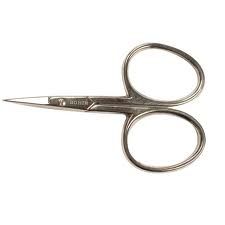
What is this?
(1) |
Embroidery scissors
|
|
|
What are embroidery scissors used for?
(4) |
General needlework
Unpicking Unclipping Making buttonholes |
|

What is this?
(1) |
Pinking shears
|
|
|
What are pinking shears used for?
(3) |
To cut a zig-zag, fray-resistant end
Used for finishing seams and raw edges |
|
|
What are serrated-edge scissors used for?
(5) |
Cutting synthetics
knits and sheer fabrics trimming close to stitching line The serrated blade prevents slipping and stretching |
|
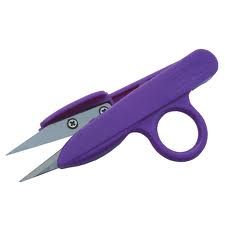
What is this?
(3) |
Thread clipper
Weaver's scissors Textile scissors |
|

What is this?
(1) |
Light trimmers
|
|
|
What are light trimmers used for?
(4) |
Repairs
alterations trimming seams small cutting jobs |
|
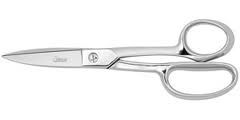
What is this?
(1) |
Sewing scissors
|
|
|
What is special about the sewing scissors?
(1) |
One blunt point prevents fabric from snagging
|
|
|
What is this?
(1) |
Draper's scissors
|
|

What is this?
(1) |
Transparent ruler
|
|

What is this?
(1) |
skirt marker
|
|
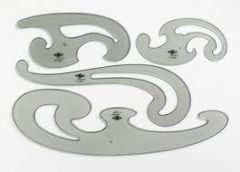
What is this?
(1) |
French curve
|
|
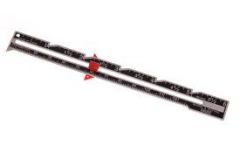
What is this?
(1) |
Sewing gauge
|
|

What is this?
(1) |
L-square
|
|
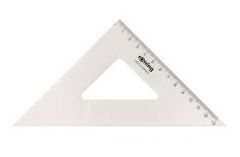
What is this?
(1) |
Set square
|
|

What is this?
(1) |
Tape measure
|
|
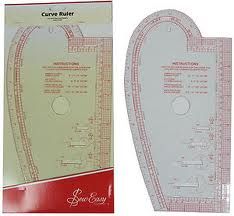
What is this?
(1) |
Curve square
|
|

What is this?
(1) |
Metre stick
|
|
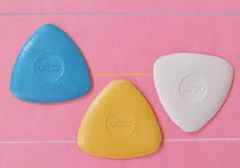
What is this?
(1) |
Tailor's chalk
|
|
|
What is tailor's chalk used for?
(2) |
Transferring pattern markings to fabric
Fitting alterations |
|
|
What is chalk in pencil form used for?
(3) |
Making thin, accurate lines
Marking pleats Buttonholes |
|
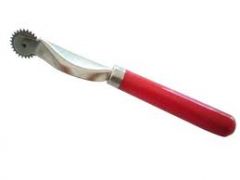
What is this?
(1) |
Tracing wheel
|
|
|
What are tracing wheels used for?
(1) |
Used with dressmaker's tracing paper to transfer pattern markings to the wrong side of fabric
|
|
|
What is a sewing gauge?
(2) |
A 15cm ruler with a slider that can be fixed at one point
Useful for hems and pleats |
|
|
What is a metre stick used for in clothing construction?
(4) |
Long, straight measurements
curtains checking grain lines marking hems |
|
|
What is a French curve use for?
(1) |
Drawing or altering curved shapes on patterns
|
|
|
What is an L-square used for?
(3) |
Finding the bias, or straight grain
altering patterns squaring off straight edges |
|
|
What is the use of a set square in clothing construction?
(3) |
Gives true right angles
Finding the bias Drawing lines at right angles |
|
|
What is the purpose of a transparent ruler?
(5) |
Lets you see what you are measuring
Has slots in it for measuring buttonholes, tucks, pleats, bias strips and guiding a tracing wheel |
|
|
What is a skirt marker?
(3) |
Tool for marking hems
Pin type (accurate) and chalk type (one person) |
|
|
What is a curve square used for?
(3) |
Measuring curves
seam allowances and buttonholes |
|
|
What is the size range of sharp needles?
(1) |
1 - 12
|
|
|
What are sharp needles used for?
(1) |
Almost all fabric weights
|
|
|
Describe the sharp needle
(2) |
Medium length
Round eye |
|
|
What is the size range for between needles?
(1) |
1 - 10
|
|
|
What is another name for between needles?
(1) |
Quilting needles
|
|
|
Describe between needles
(1) |
Same as sharps, but shorter
|
|
|
What are between needles used for?
(1) |
Taking fine stitches in heavy fabric
|
|
|
What is the size range that ball-point needles come in?
(1) |
5 - 10
|
|
|
Describe ball-point needles
(1) |
Same as sharps except for having a rounded point
|
|
|
What are ball point needles used for?
(1) |
Knits
|
|
|
What size range do straw needles come in?
(1) |
1/0 - 12
|
|
|
Describe a straw needle
(1) |
Longer than other needle types
|
|
|
What are straw needles used for?
(1) |
Tacking
|
|
|
What sizes do self-threading needles come in?
(1) |
4 -8
|
|
|
Describe the self-threading needle
(1) |
Same as sharp, except it has a slot instead of an eye
|
|
|
What lengths do dressmaker's pins come in?
(2) |
25mm (standard)
30mm |
|
|
What are dressmaker's pins made from?
(4) |
nickel-plated steel
brass nickel-plated brass stainless steel |
|
|
What fabrics are dressmaker's pins used for?
(1) |
Most fabrics
|
|
|
What size do lace pins come in?
(1) |
Extra fine 25mm
|
|
|
What fabrics are lace pins used on?
(1) |
Delicate fabrics
|
|
|
What are lace pins made from?
(2) |
Nickel-plated brass
stainless steel |
|
|
What are coloured-head pins also known as?
(2) |
Glass-headed pins
Marking pins |
|
|
Describe coloured-head pins
(3) |
Long (30mm)
fine pins with rounded glass or plastic heads |
|
|
What is the point of coloured head pins?
(2) |
Easy to see
and handle |
|
|
What are coloured head pins made of?
(2) |
Stainless steel
nickel-plated steel |
|
|
What are T-pins used for?
(2) |
Heavy pile fabrics
loose knits |
|
|
Describe twist pins
(2) |
Plastic heads
Twisted stem |
|
|
What are twist pins used for?
(1) |
Holding things in place, such as loose covers
|
|
|
What are plastic pins used for?
(2) |
Hanging and
pleating curtains |
|
|
How should you care for an automatic iron?
(5) |
Store in cupboard
Disconnect when not used Never overheat Keep clean and smooth Cord should be in one piece, no broken edges |
|
|
How do you care for a steam iron?
(6) |
Used boiled or distilled water; Disconnect when not used; Don't wind flex around iron ; Discard left over water after use; Rest on end piece;
Wipe base with damp cloth while lukewarm and polish with dry cloth |
|
|
Describe an ironing board
(3) |
Skirt length
Height adjustable Covered top |
|
|
Describe a sleeve board
(4) |
Padded surface
55cm long 10cm wide round point |
|
|
What is a sleeve board used to iron?
(4) |
seams
narrow garment sections necklines sleeve heads |
|
|
What is a press mitt?
(4) |
Glove like cushion
made from scorch proof, heat reflecting surface With a pocket to slip hand into can be slipped over the end of a sleeve board |
|
|
What is a press mitt used for?
(1) |
Pressing rounded sleeve heads
|
|
|
What is a tailor's ham used for?
(2) |
Pressing shaped areas (bust darts, curved seams)
Moulding collars |
|
|
Describe a seam roll
(2) |
Firmly packed
cylindrical cushion |
|
|
What is a seam roll used for?
(2) |
Pressing long curved seams
and seams in very narrow areas |
|
|
What is a velvet or needle board?
(2) |
A pressing surface for pile fabrics
steel wires mounted on a backing of heavy canvas |
|
|
How does a needle board work?
(3) |
Pile fabric placed face down on board
Wires fit between the pile Keep pile from matting during pressing |
|
|
What is another name for a tailor's pounding block?
(1) |
Dressmaker's clapper
|
|
|
What is a tailor's pounding block?
(2) |
A rounded wooden block
Used to obtain sharp creases in heavy fabrics |
|
|
How do you use a dressmaker's clapper?
(2) |
Press bulky edge of garment with steam iron
Pound it with block |
|
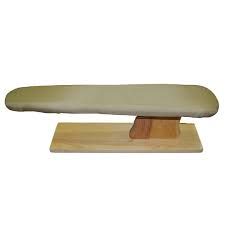
What is this?
(1) |
Sleeve board
|
|
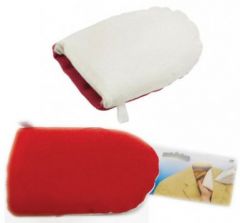
What is this?
(1) |
Pressing mitt
|
|
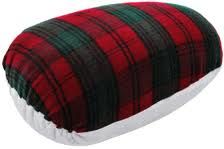
What is this?
(1) |
Tailor's ham
|
|
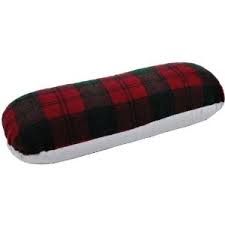
What is this?
(1) |
Seam roll
|
|
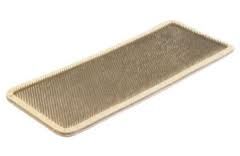
What is this?
(1) |
Needle board
|
|
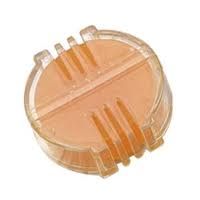
What is this?
(1) |
Beeswax
|
|
|
What is beeswax used for?
(2) |
Strengthen thread for hand sewing
Reduce tendency to tangle and knot |
|
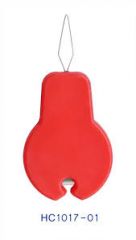
What is this?
(1) |
Needle threader
|
|
|
What is the purpose for a needle threader?
(1) |
Eases threading of hand or machine needles
|
|
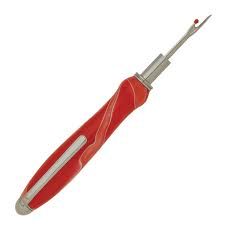
What is this?
(1) |
Seam ripper
|
|
|
What is a seam ripper?
(3) |
sharp, curved edge for cutting seams open
point for picking out threads slashing machine worked buttonholes |
|
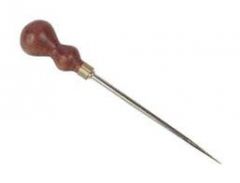
What is this?
(1) |
Awl / stilletto
|
|
|
What is another name for an awl?
(1) |
stilletto
|
|
|
What is an awl used for in sewing?
(2) |
A small, sharp instrument that makes round holes needed for eyelets
or keyhole buttonholes |
|
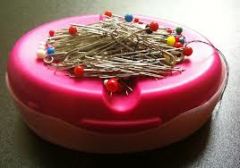
What is this?
(1) |
magnetic pin holder
|
|
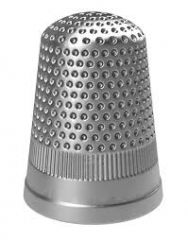
What is this?
(1) |
thimble
|
|
|
What is a thimble used for?
(1) |
Protects middle finger during sewing
|
|

What is this?
(1) |
Bodkin
|
|
|
What is a bodkin?
(3) |
Long, blunt needle
used for threading elastic or cord through a casing can turn bias tubing |
|
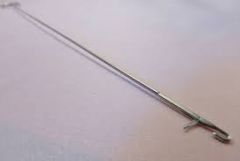
What is this?
(1) |
Loop turner
|
|
|
What is a loop turner?
(2) |
Long, wirelike bodkin with a hook at one end
for grasping fabric when turning bias tubing to the right side |
|
|
Name the 11 types of machine needle
(11) |
Very light ball point / Universal ; medium ball point;
Light ball point ; Stretch; jeans ; leather ; double ; triple needle ; hemstitch ; special twin hemstitch ; cordonett |
|
|
What is the universal needle used for?
(2) |
Normal sewing
Most fabrics |
|
|
What is the medium ball point needle used for?
(2) |
Cotton knits
Synthetic fabric |
|
|
What is a stretch needle used for?
(2) |
Highly stretch fabric
Only if problems experienced |
|
|
What is the jeans needle used for?
(3) |
Heavy weight fabric
denim canvas |
|
|
What is special about a jeans needle?
(2) |
Sharp pointed
very hard |
|
|
How is the leather needle special?
(1) |
Point twisted to right or left
|
|
|
What is a double needle used for?
(2) |
Needle spacing
size needle |
|
|
What is a triple needle used for?
(2) |
Needle spacing
size needle |
|
|
What is a hemstitch needle used for?
(1) |
Decorative hemstitch effect
|
|
|
What is a special twin hemstitch needle used for?
(1) |
Decorative stitching
|
|
|
What is a cordonett needle?
(2) |
Light ball point
with eye |
|
|
What is a cordonett needle used for?
(1) |
Top stitching with thick thread
|
|
|
Name the six types of thread used in garment construction.
(6) |
Mercerised ; polyester ; nylon ; cotton-covered polyester ; Buttonhole twist; elasticated
|
|
|
What thread colour would you choose for a plain coloured fabric?
(1) |
Same colour, but a shade darker
|
|
|
What thread colour would you choose for a multi-coloured fabric with a dominant colour?
(1) |
Same colour as the dominant colour
|
|
|
What thread colour would you choose for a multi-coloured fabric without a dominant colour?
(1) |
The same colour as the darkest colour
|
|
|
What factors should you consider when buying a sewing machine?
(7) |
What you will use it for ; well known, reliable manufacturer ; guarantee ; after-sales service ; parts easily available ; free lessons ; consider the negative and positive aspects of the machine
|
|
|
How do you care for a sewing machine?
(4) |
Clean regularly ;
brush dust and fluff from under the stitch plate, bobbin and bobbin case; dust machine parts ; oil once a week if used regularly ; |
|
|
What is the purpose of the spool pin?
(2) |
Keep thread spool in position during stitching
and winding thread on the bobbin |
|
|
What is the purpose of the thread guide?
(2) |
guide thread during threading
and controls movement of the thread during stitching |
|
|
What is the function of the needle position selector?
(1) |
Moves the position of the needle
|
|
|
What is the purpose of the bobbinwinder?
(1) |
Winds thread from the reel onto bobbin
|
|
|
What is the purpose of the tension disks?
(1) |
Controls the movement of the thread by putting tension on it.
|
|
|
What is the purpose of the presser foot?
(1) |
Keeps fabric in position during stitching
|
|
|
What is the purpose of the needle?
(1) |
Moves through fabric, forms loop with the thread of the bobbin and forms a stitch on the fabric.
|
|
|
What is the purpose of the pressure regulator?
(1) |
controls the amount of pressure that is put on fabric during stitching.
|
|
|
What is the purpose of the feed dog?
(1) |
Feeds fabric evenly to the back, so that stitches can be formed
|
|
|
What is the purpose of the bobbin?
(1) |
Provides bottom thread that forms a stitch with the top thread.
|
|
|
What is the purpose of the stitch length regulator?
(1) |
Controls the length of stitches
|
|
|
What is the purpose of the needle clamp?
(1) |
Keeps needle in position
|
|
|
What is the purpose of the handwheel?
(1) |
Starts stitching process by being moved by hand in the direction of the seamstress
|
|
|
What is the result of too much machine pressure?
(2) |
Too much tension
and too little thread |
|
|
What is the result of too little machine pressure?
(2) |
Too little tension
and too much thread |
|
|
How can you tell when the top tension is too tight?
(1) |
Link in stitch falls towards top layer of fabric
|
|
|
How can you tell if the top tension is too loose?
|
Link will lie toward the bottom layer of fabric.
|
|
|
Define the term "stitch length"
(2) |
The length of stitches in a stitching
It is given in the amount of stitches in a specific length-unit |
|
|
How do you determine the stitch length?
(1) |
Count the number of stitches in a length-unit
|
|
|
What is a short stitch length?
(2) |
16 - 24 stitches per 25 mm
Mainly for seaming lightweight fabrics |
|
|
What is a regular stitch length?
(2) |
10 - 15 stitches per 25 mm
general sewing |
|
|
What is a tacking stitch?
(4) |
6 - 9 stitches per 25 mm
Used for easing, gathering and top stitching |
|
|
How do you choose stitch width?
(3) |
Shorter for lighter fabric
Wider for edge finishing fraying fabric Set according to desired effect for decorative stitches |
|
|
How would you solve the following problem?
Needle comes unthreaded when beginning a row of stitching (1) |
Take-up lever at highest point when beginning to stitch
|
|
|
How would you solve the following problem?
Thread knots up on underside of fabric when beginning to stitch (1) |
Hold thread ends under and behind presser foot when beginning
|
|
|
How would you solve the following problem?
Bottom thread lies along surface of fabric (1) |
Tighten top tension
|
|
|
How would you solve the following problem?
Upper thread lies along surface of fabric (1) |
Loosen top tension
|
|
|
How would you solve the following problem?
Lightweight fabric caught and pulled down into needle hole of throat plate (1) |
Use straight-stitch throat plate when straight stitching because it has a smaller needle hole
|
|
|
How would you solve the following problem?
Stitches buried in fabric (1) |
Check stitch length
|
|
|
How would you solve the following problem?
Machine jams and makes knocking noise. Thread caught in shuttle (1) |
Remove bobbin case and clean out any threads
|
|
|
How would you solve the following problem?
Machine skips stitches (3) |
Needle inserted correctly
Needle right size for fabric Sewing knits, then follow correct procedure |
|
|
What is the best way to prepare the machine and fabric before sewing knits?
(5) |
Use ballpoint needle
Use straight-stitch throat plate Pressure regulator is normal to heavy launder knits to remove residue Balance machine tension |
|
|
How would you solve the following problem?
Fabric does not move (4) |
Lift feed dog up
Put pressure foot down Increase pressure on presser foot See if thread knotted under fabric |
|
|
How would you solve the following problem?
Upper thread breaks (2) |
Ensure machine properly threaded
Loosen upper tension |
|
|
How would you solve the following problem?
Bobbin thread breaks (2) |
Ensure bobbin properly threaded
See if thread caught in shuttle |
|
|
How would you solve the following problem?
Stitching puckers (3) |
Ensure needle not bent or blunt
Check thread tension Check pressure regulator |
|
|
How would you solve the following problem?
Needle breaks (5) |
Ensure correct needle size
Ensure inserted correctly Tighten presser foot Avoid pulling fabric Avoid stitching over pins |
|
|
Name brands of domestic sewing machines
(9) |
Bernina ; Janome
Bernette ; Singer Elna ; Finesse Phaff ; Husqvarna Empisal |
|
|
Name brands of industrial sewing machines
(10) |
Union special ; Mitsubishi
Singer ; Harrison Phaff ; Brother Juki ; Rimoldi Toyota ; Afsew |
|
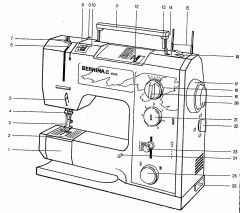
What is at number 1?
(1) |
Hinged front cover
|
|
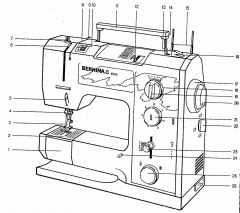
What is at number 2?
(1) |
Stitch plate
|
|
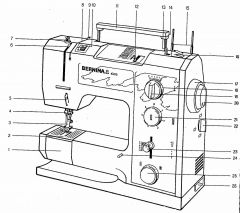
What is at number 3?
(1) |
Presser foot
|
|
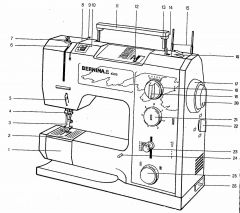
What is at number 4?
(1) |
Needle clamp
|
|
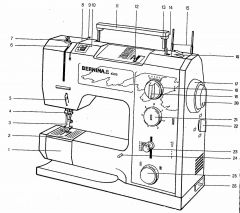
What is at number 5?
(1) |
Thread regulator
|
|
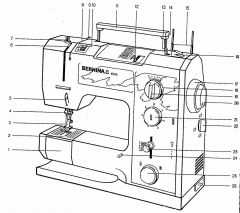
What is at number 6?
(1) |
Thread take up lever
|
|

What is at number 7?
(1) |
Pre-tension stud
|
|

What is at number 8?
(1) |
Thread tension slot
|
|

What is at number 9?
(1) |
thread guide
|
|
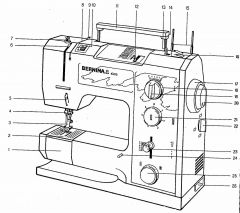
What is at number 10?
(1) |
Thread tension adjustment knob
|
|

What is at number 11?
(1) |
Retractable carrying handle
|
|

What is at number 12?
(1) |
Stitch selector lever
|
|
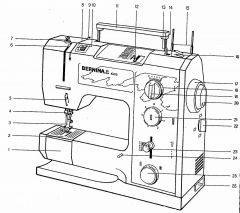
What is at number 13?
(1) |
Bobbin spindle
|
|
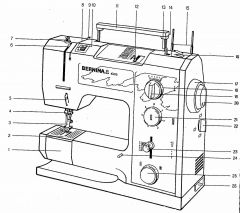
What is at number 14?
(1) |
Supplementary thread guide
|
|
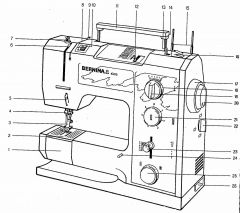
What is at number 15?
(1) |
Thread holder pins
|
|

What is at number 16?
(1) |
Bobbin winder slot
|
|
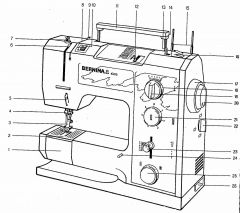
What is at number 17?
(1) |
Handwheel
|
|
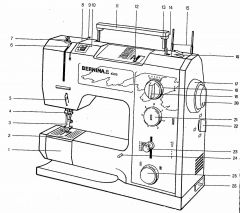
What is at number 18?
(1) |
Stitch width knob
|
|
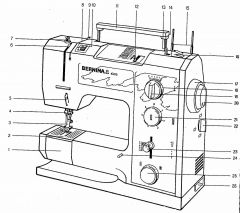
What is at number 19?
(1) |
Needle position knob
|
|
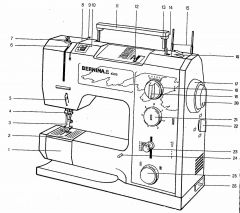
What is at number 20?
(1) |
Handwheel release
|
|
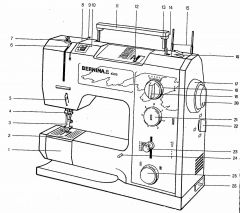
What is at number 21?
(1) |
Buttonhole knob
|
|
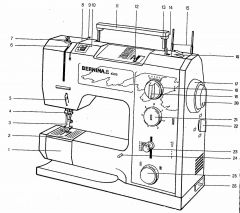
What is at number 22?
(1) |
Power / light switch
|
|
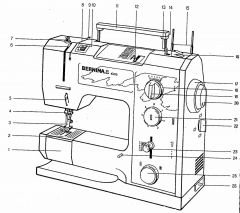
What is at number 23?
(1) |
Stitch length knob
|
|
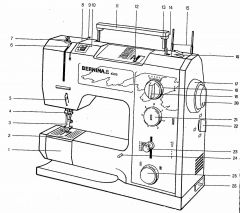
What is at number 24?
(1) |
Securing pins for sewing table
|
|
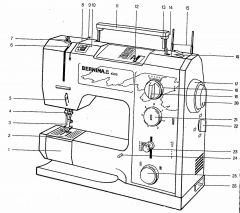
What is at number 25?
(1) |
Sewing / darning selector knob
|
|
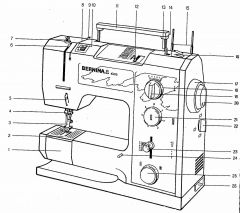
What is at number 26?
(1) |
Combined mains and foot control socket
|
|
|
What is the purpose of the flywheel in a sewing machine?
(1) |
Disengage the needle
|
|
|
What is the purpose of the slide plate in a sewing machine?
(1) |
Covers the bobbin and its case
|
|
|
What is the purpose of the take-up lever?
(1) |
Moves downwards so that the upper thread is slack while the stitch is formed
|
|
|
How does an overlocker work?
(4) |
Fabric passes through the feed dogs
then two blades trim the edges neatly the loopers and needles form the overlock stitches the stitches move over the stitch fingers before they slip off. |
|
|
What types of overlockers are there?
(3) |
Two spools
Three spools Five spools |
|
|
Describe the three thread overlocker
(3) |
One needle
Two loopers Can do a three-thread overlock stitch |
|
|
What is the three-thread overlock stitch used for?
(3) |
Knit fabrics
Finishing seam allowances Reversible articles |
|
|
Why is the three-thread overlock stitch useful on knits?
(2) |
It stretches with the fabric
|
|
|
Why should you not use the three-thread overlock stitch to seam woven fabrics?
(1) |
Not very sturdy
|
|
|
Why is the three-thread overlock stitch useful for reversible articles?
(1) |
It looks the same on both sides
|
|
|
What is the three-thread overlock stitch able to be adjusted to do?
(2) |
Sew flat seams
Stitch a rolled hem |
|
|
Describe the four-thread overlocker
(2) |
Two needles
Two loopers |
|
|
What stitches can be made with a four-thread overlocker?
(3) |
Three-thread overlock stitch
Four-thread safety stitch Four-thread mock safety stitch |
|
|
Describe the four-thread safety stitch
(2) |
Three-thread overlock stitch
with extra line of stitches that catch the loops |
|
|
What is the benefit of the four-thread safety stitch?
(1) |
The extra thread makes the seam stronger
|
|
|
How does the four-thread mock safety stitch differ from the four-thread safety stitch?
(3) |
The loops of the lower looper are caught by both needles.
Loops of the upper looper are caught only by the right-hand needle A line of stitches is formed on top, next to the overlock stitches |
|
|
What is a five-thread overlock stitch equivalent to?
(1) |
Doing a straight and zig-zag stitch on a sewing machine
|
|
|
Describe the five thread overlocker
(2) |
Two needles
Three loopers |
|
|
What stitches can the five-thread overlocker stitch?
(3) |
Three-thread overlocking stitch
Chain stitch Five-thread overlock stitch |
|
|
Describe the five-thread overlock stitch
(2) |
Two-thread chain stitch
and three-thread overlock stitch sewn together |
|
|
How is a chain stitch made on an overlocker?
|
Needle and lower looper
Needle forms a straight line of stitching on top Looper thread interlocks to form a chain underneath |
|
|
What is special about an overlocker's chain stitch?
(3) |
Very secure
Does not stretch Only overlocker stitch not on the fabric's edge |
|
|
Describe differential feed
(3) |
Has two sets of metal teeth (feed dog)
that can function independently Allows twice as much fabric to be passed through the front feed dog than comes out the back |
|
|
What is the purpose of differential feed?
(3) |
Prevents knits from stretching during stitching and so curling up
Prevents wavy seams Gathering |
|
|
What is an overlocker used for?
(4) |
Finishing edges
Stitch a seam, trim raw edges and overlock in one step Decorative stitching Specialised sewing (threading elastic, rolled hems, blind hems) |
|
|
What can an overlocker NOT do?
(4) |
Sew straight zig-zag stitch
Sew decorative stitches Make buttonholes Sew in a zip |
|
|
What are the requirements for overlocking thread?
(4) |
Strong
Smooth Without woolly fluff Rolled crosswise |
|
|
What specialised feet are available for overlockers?
(5) |
Rolled hem
Blind hem Elastic gathering Cording Beading |
|
|
Where is the seamline formed on an overlocker?
(2) |
Where the needle enters the fabric
When two needles are used, the left-hand needle |
|
|
How does a zigzag stitch's width and length change for the thickness of fabric?
(2) |
thin fabric = short, narrow stitches
Thick fabric = Long, broad stitches |
|
|
How do you remove the thread from an overlocker's stitch fingers?
|
Lift foot and needle
Pull thread out for the needle to about 1,5cm above eye Pull chain gently behind the foot. |
|
|
How do you start stitching with an overlocker?
|
Stitch a chain for about 7cm
Place fabric in position and stitch about 3 stitches Stop with needle in fabric and lift presser foot. Bring the chain forward and under the foot. Pull on the chain to elongate it and have it lying on the edge Drop the foot and stitch the seam |
|
|
What are the four methods of finishing stitching with an overlocker?
|
1. Snip the end of the chain off against the fabric and seal it with fabric glue
2. Sew the chain in under the stitching. 3. Knot the ends of thread and cut against the knot 4. Stitch to the end of the seam and make one further stitch beyond. Lift the foot and put it in line with the needle plate again and stitch about 2cm back over it. |
|
|
How do you stitch curves with an overlocker?
|
Hold the fabric so that stitching line is formed as straight as possible.
Lift the foot every few stitches and turn the fabric in the new direction. Use both hands to manipulate the fabric |
|
|
How do you stitch outer corners with an overlocker?
|
1.Cut to correct size or mark cutting line. Snip a notch in the corner up to the cutting line. Stitch to about 2cm from the corner and then fold right-hand side of fabric under so forms a straight line. Lower the foot and complete
|
|
|
How do you stitch an outside corner with a sewing machine?
|
Stitch to end of fabric, hold hand on flywheel, stitch one stitch off the fabric and clean the stitch fingers. Turn the fabric, lower the needle into the fabric on corner where previous overlock stitches are. Continue stitching.
|
|
|
How do you stitch around a circle or oval with an overlocker?
|
If seam allowance is more than 6mm wide, make a cut in two spots 5cm apart and cut the seam allowance away. Skip this if seam allowance is less than 6mm.
Lift presser foot and place fabric so cut away is in line with the blade. Lower presser foot onto fabric. Stitch around fabric until you have stitched over first two or three stitches again. Pull thread through eye of needle by hand until it's about 7,5cm long. Lift presser foot and pull fabric towards back to remove stitches from stitch fingers. Finish off |
|
|
How do you reinforce seams when stitching with an overlocker?
|
Use cotton binding or cord of about 6mm wide.
Stitch over cord or binding, to the right of seamline. |
|
|
What are the requirements of decorative thread used in overlockers?
|
Thread must pass through eye of looper easily
Thread must be able to give in order to form stitches evenly. Choose thread smooth and even so moves through guides easily. Buy enough to finish article. 7m of thread are required for every metre stitched. |
|
|
What is flatlocking?
|
Where seams are formed by overlocking two layers of fabric together and then pulling them apart so that seams lie flat.
|
|
|
What can cause missed stitches on an overlocker?
|
Needle too thick for fabric
Upper looper tension too tight Needle blunt or bent Incorrectly threaded Faulty needle |
|
|
What causes loops to form on the right side of fabric when overlocking?
|
Needle tension too loose
Stitch width incorrect for fabric Thread not completely through tension plates Thread not through all guides Needle blunt or bent Blade not correctly in position |
|
|
What causes thread breaks on overlockers?
|
Threading incorrect
Tension too tight Thread caught at spool or spool holder Needle blunt or bent Poor quality thread |
|
|
What causes loops on the edge of fabric when overlocking?
|
Thread not properly between tension plates
Looper threads too loose Thread slipping out of guides Blade cutting off too much fabric |
|
|
What causes overlocker jams?
|
Presser foot too heavy for fabric
Thread caught under presser foot |
|
|
What factors need to be considered when deciding what overlocker to buy?
|
Price
easy handling versatility Safety After-care service |
|
|
How do you maintain an overlocker?
|
Use a dust cover, not fabric
Clean the machine regularly Have the machine serviced regularly |

